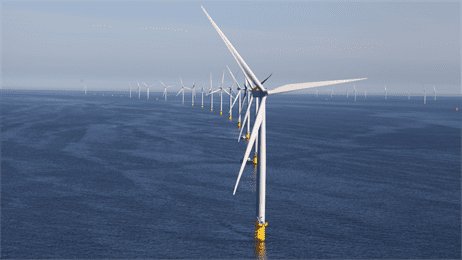A report from Carbon Brief shows that the UK generated more electricity from wind than from coal during 2016.
The milestone is a first for the UK and reflects a collapse in coal generation, which contributed just 9.2% of UK electricity last year, compared to 11.5% from wind. The coal decline saw its output fall to the lowest level since 1935.
It also means CO2 emissions from UK power generation will have fallen by around 20% in 2016, as coal was largely replaced by lower-emissions gas. This reduction will be enough to cut overall UK CO2 emissions by 6% for the year, if other sectors’ emissions are unchanged.
Carbon Brief’s estimates of UK electricity generation and emissions in 2016 are based on a range of sources and our own analysis. (See below for details.) The Department of Business, Energy and Industrial Strategy (BEIS) will publish its own estimates on 30 March.
Wind beats coal
The past 12 months have seen a year of firsts for the UK’s electricity system. At the broadest level, the UK grid is changing as centralised power stations are joined by thousands of smaller sites, particularly renewables, as part of efforts to decarbonise electricity supplies.
Other important factors include falling electricity demand, rising imports from continental Europe and changes in the relative price of coal and gas on wholesale energy markets. The UK’s top-up carbon tax, the carbon price floor, also doubled in April 2015.
In March 2016, as Carbon Brief analysis revealed, coal generation fell to zero for the first time since public electricity supply started in 1882. Wind generated more electricity than coal in April 2016, the first month this had ever happened.
Then Carbon Brief analysis showed solar also generated more electricity than coal in April, again the first month this had ever happened. Solar went on to generate more power than coal during the half year from April to September 2016.
Now, Carbon Brief analysis of the full twelve months of 2016 shows that wind generated more electricity than coal, as the chart below shows. This first was possible largely because of falling coal generation, which was down 59% on a year earlier.
UK electricity generation by source, terawatt hours (TWh). Source: BEIS Energy Trends table 5.1 and Carbon Brief analysis (see below). Chart by Carbon Brief using Highcharts.
As the chart shows, this drop in coal output in 2016 was largely filled by an increase in gas generation, which was up 45% year on year. However, it’s worth noting that generation from coal and gas combined has fallen by 38% since 2010, when the coalition government took office.
Some 68% of the reduction in fossil-fuelled electricity since 2010 has been substituted with low-carbon sources, mainly renewables. Imported power replaced another 22% and reduced consumption accounted for the remaining 10%.
As a result of these changes, CO2 emissions from UK electricity generation in 2016 were approximately half those in 2010. Last year saw a particularly dramatic 20% reduction, Carbon Brief analysis shows, as coal use fell sharply.
Coal collapse
The reduction in coal generation during 2016 was a continuation of several years’ decline, such that output is now down nearly 80% since a 2012 peak, as the chart below shows.
UK annual electricity generation by source, terawatt hours (TWh). Source: BEIS Energy Trends table 5.1, historical electricity data and Carbon Brief analysis (see below). Chart by Carbon Brief using Highcharts.
The amount of electricity generated by coal-fired power stations in 2016 – at an estimated 31 terawatt hours (TWh) – was the lowest since around 1935, Carbon Brief analysis suggests. That year, President Roosevelt opened the giant Hoover Dam in Nevada and Hitler began remilitarising Germany.
Coal’s share of 2016 electricity generation, at 9.2%, was the lowest ever. Even during the peak of the miners’ strike in 1985 (seen in the marked dip in coal output on the chart), coal generated some 45% of UK power, with oil and nuclear making up the remainder.
In spring 2016, three UK coal-fired power stations closed down. The UK plans to close all of its remaining coal plants by 2025.
Seasons of change
It’s worth looking more closely at last year’s record-breaking 12 months for UK electricity, in the month-by-month chart, below. You can see that coal’s share of generation fell as low as 2.5%, in the month of August.
UK monthly electricity generation by source, gigawatt hours (GWh). Source: BEIS Energy Trends table 5.1 and Carbon Brief analysis (see below). Chart by Carbon Brief using Highcharts.
You can also see how wind and solar output are complementary: more electricity is generated by solar in summer, while wind turbines are most productive in winter.
One final point of interest is the uptick in overall electricity generation towards the end of 2016. This was a result of falling electricity imports from France, where an ongoing crisis has closed a number of nuclear power stations.
This uptick is reflected in the annual chart, where total UK electricity generation increased between 2015 and 2016.
Notes
Carbon Brief’s estimates for UK electricity generation in 2016 are based on the following sources: BEIS electricity generation figures for Q1-Q3, from Energy Trends table 5.1 (“electricity generated by all operating companies”).
This data was supplemented with BM Reports figures for grid-connected generation during October, November and December. Solar generation estimates for these months comes from Sheffield Solar.
Carbon Brief estimated the output from embedded generation not connected to the UK grid, using statistical methods based on previous months’ data. Embedded generation is predominantly made up of solar and onshore wind, as well as some gas-fired plant at industrial sites.
Bioenergy includes biomass, such as the wood pellets burned at Drax in Yorkshire, as well as energy from landfill gas and other wastes.





